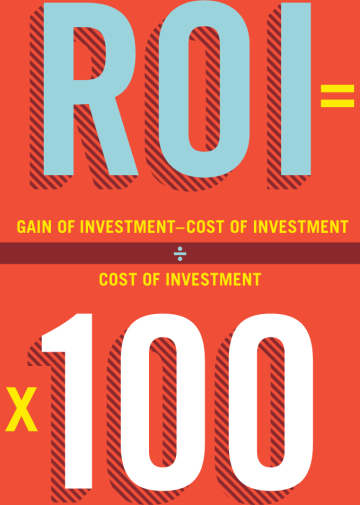Defining Metrics to Promote the Value of your Creative Work
Metrics, metrics, metrics! Setting business metrics, measuring return on investment, quantifying value—when did design go all Wall Street?
If your professional training was steeped in creative development, and the metric system was the closest you ever got to “metrics” (but heck, you’re much more comfortable with points, picas, and pixels), then the thought of measuring your creative impact probably ranks somewhere between word problems and tax preparation on your fun list.
All snark aside, the focus on numbers has been a significant obstacle for designers to overcome. Whether it stems from an inability to place measurable parameters on creative work, or from fine art roots that culturally emphasize aesthetics, we don’t like proving our worth with spreadsheets. But our relatively young profession has matured to a level where, if we are to make the argument that “design can change businesses and culture,” then we have a responsibility to demonstrate how. And numbers, well, they’re the universal language.
In recent years, there has been a stronger push for organizations to allocate resources to endeavors that are results-based. When budgets are tight, everyone wants assurances that the work they commission will yield measurable returns, and rightfully so. Understanding the numeric impact of your work makes you a better advocate for design, a better business partner, and ultimately, better at selling your services.
Determining which metrics best suit the assignment is also part of your job. (Better your determination than someone else’s.) Measurement doesn’t always require financial framing. Understanding a range of assessment concepts will provide you with the right evaluation tools for each project. There is an art to establishing functional metrics.
- The good news is, like most everything else, it’s about 5 percent talent, 5 percent experience, and 90 percent practice.
Setting Metrics: Return on Investment
The most common and broadly used tool to establish financial success in business is return on investment (ROI). ROI is a basic measure for determining profits earned by a specific business investment.
It can be used to formulate the rate of return on projects, processes, and business decisions. Showcasing high rates of return for the work commissioned, or being able to discuss positive returns for previous projects, enables design activities to be favorably showcased to clients in terms that they understand and value.
ROI is most commonly discussed as a percentage or a ratio, calculated by dividing returns (money made by the project) by the initial cost of funding an endeavor or investment. The most basic formula for ROI is expressed as:
- (Gain of Investment - Cost of Investment) / Cost of Investment x 100 = % ROI
For a simple example, if the design and production of marketing materials cost $10,000 (design fees, copywriting, printing, paper, shipping all included) and helped foster $60,000 in new sales, then ROI for the project would be 500%. The calculation looks like this:
- $60,000 (Gain of Investment) - $10,000 (Cost of Investment) = $50,0001
- $50,000 / $10,000 = 51
- 5 x 100 = 500% ROI
Using this equation, any percentage greater than zero indicates that the investment yield is more than the initial cost. Higher percentages indicate more profitable investments and better business decision making. Simple, right?
Return on investment is often used as a summative evaluation, meaning in order to thoroughly understand the relationship between the initial investment and the return, you have to see the payoff. It evaluates a project after it is completed.
One obstacle when applying simple ROI calculations to design projects is that often the work commissioned is not easily broken out from other factors that influence consumer decision making. In the example above, what role did the design of the material play in purchasing decisions? How can the design of the material be separated from the efforts of the sales staff using it? Were other market forces at work, like the bankruptcy of a competitor, which may have influenced the subsequent increase in sales?
Some types of design practice are easier to evaluate with ROI than others. For example, packaging design is highly influential because of its direct consumer connection. How often have you knowingly overpaid for soap, lotion, candles, or chocolate bars because the package was so unique, lovely, homespun, or luxurious that you just “had to have it”? Often, these purchases are of products that the consumer has had no previous encounter with via advertisement or sales staff interaction. Positive brand associations, in these cases, are highly linked to the design of the packaging—and we can therefore measure the ROI of that design with less complication from additional factors. In contrast, design for business-to-business collateral, especially that which supports the interpersonal efforts of sales staff, is more difficult to measure in terms of ROI. You can calculate numbers, but they’re more subjective because of the additional forces at play.
- If design is only one part of the total picture (and that’s almost always true), find additional ways to evaluate success.
In the marketing materials example used at left, evaluation beyond ROI might involve partnering with the client to determine what role the materials played in closing sales and fostering new business. This can be achieved through ethnographic review, including surveys and interviews with sales staff and the clients served. Conversations with the individuals involved can lead to invaluable insight on how design influences consumer decisions. Factoring other metrics into your summative analysis will paint a broader picture of the value generated.

This 10-year retrospective box set, designed for Fontsmith by Thompson Brand Partners (shown at left and on the next page), delivered big results in several key areas: Fontsmith’s sales increased by 53 percent, and corporate licensing went up 255 percent. The end result is a 415 percent return on investment in the first year after project launch (ROI OMG).


